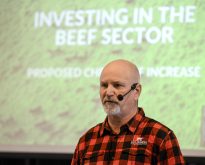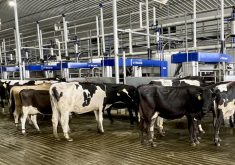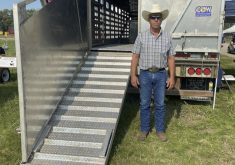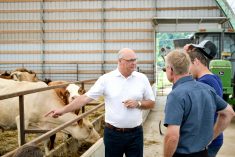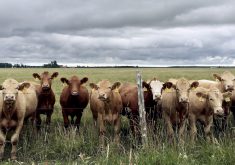Glacier FarmMedia – People working with cattle often recognize different personality types among individuals.
There are the friendly calves, the shy ones and the curious types. Research from the University of British Columbia has been able to quantify personality types among dairy calves and that knowledge could improve their welfare.
Why it matters: If researchers and farmers better understand calf behaviour, it can lead to more beneficial animal welfare practices.
“In the agriculture industry we have tended to use the word temperament and not personality. The whole field is evolving. Temperament was probably more appropriate when people started working in this area,” said Marina von Keyserlingk, the Natural Sciences and Engineering Research Council of Canada (NSERC) industrial research chair at the UBC welfare program.
Read Also

BinSentry sensors reduce feed-bin outages
BinSentry sensors mean fewer feed bin outages and more efficient deliver for feed mills.
Early studies on temperament were typically based on the single trait of fearfulness. Young beef cattle placed in a squeeze chute were watched and measured to see how fast they would exit as an indicator of fearfulness.
More recent work is looking at five main traits: shyness-boldness, exploration-avoidance, activity, sociability and aggressiveness.
“We are looking at this much more nuanced than we have in the past,” von Keyserlingk said.
She and her team have published a series of papers looking at individual variation.
“We tend to manage animals as groups or herds. Farmers know that they are all different,” she said.
“When we are talking about welfare, we are talking about the individual. It is the individual that can suffer. How do we create environments that work for all animals in the pen, not just the average,” she said.
Fearfulness is the general susceptibility to react to a variety of potentially threatening situations. Bolder animals may take risks while the shyer ones are more careful. Sociability is the propensity of an individual to keep close contact with others. Recent work in farm animals showed individual differences for these traits on a consistent basis over time.
Traits like pessimism were also measured. The results suggest more pessimistic animals react more intensely to emotional challenge, perhaps because they have worse expectations than others. Other research has shown pessimistic people also react more strongly to challenges.
A personality trait has to be consistent across context and time. This research is among the first projects to be completed although some science has shown pigs and dolphins may exhibit traits like pessimism.
Working at the Aggassiz research centre in B.C.’s Lower Mainland, researchers watched calves 30-50 days old to see how they reacted to something novel like a new bucket or a different person.
Over that time, calves that were more fearful or exploratory at 30 days of age behaved the same when they were 50 days old.
Other work evaluated what happens to dairy heifers when they enter puberty at about seven to 10 months of age.
“We were interested in learning how personality changes as life stages change,” von Keyserlingk said.
A graduate student monitored animals in four stages of life from the time they were very young until they had their first calf at about 2-1/2 years old.
They were consistent throughout that time except when they went through puberty.
At that time the heifers changed but there was no consistency in their behaviour and researchers are still trying to understand this.
“We see the same things in humans. In teenagers is when we see these potentially dramatic changes in personality traits. We just showed the same thing in cattle,” she said.
The UBC team has also studied individual housing for young dairy calves. They are often raised in separate hutches to prevent the spread of disease but von Keyserlingk and others have found those that were socialized with a buddy were calmer, explored more and were easier to handle than those kept isolated. Restrictive housing leaves them bored and leads to bad behaviours.
“They have never been in an environment where anything has touched them before and some are going to be way worse than others,” she said.
This knowledge could be included in renewed codes of practice and best management practices.
“The evidence is out there that if you have very small groups like a pair, there is no increase in disease compared to individual housing,” she said.
A large group of 20 could have more disease and they commingle more as calves come and go.
“Individual housing, we have to get away from that. It is not good for the calves, and it is going to be a tough one to sell to the public,” said von Keyserlingk.
“Calves that are socially reared are better learners than those calves that are individually housed,” she said.
This article was originally published at The Western Producer.





